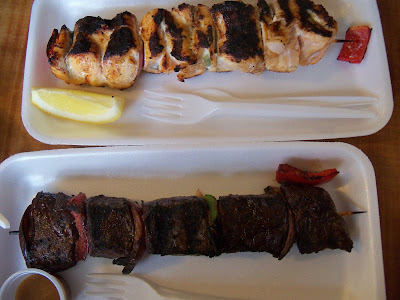 |
| Slipper/Sandal that belonged to Sulpicia Lepidina, who also wrote the birthday invitation also found at Vindolanda -- this is the oldest piece of female handwriting found in Europe |
One thing they recently found was the body of a murdered girl buried in a shallow grave in the barracks, with her hands bound. The archeologist said it was really tough to work on.
The top thing about it is that they do a fantastic job of contextualizing everything and telling as much as possible about everyday ancient Roman life. For this area of northern England, they didn't enjoy the same standard of living as the ancient Roman period until the 18th-19th century, and some people didn't have running water until after the second World War. So to see the complexity and efficiency of the ancient Roman settlements is really impressive.
While some products were made locally, like beer, they have found evidence at Vindolanda of olive oil from the region around Seville, Spain and northern Africa, glass from around Cologne, Germany, and amber from the Baltic region, and many products from Gaul. Many objects are exceptionally well-preserved because the wet conditions and soil conditions made the conditions anaerobic, which of course slows decay. They've also found paper fragments there, giving an incredible insight into everyday communication among the inhabitants, including an invitation from the CO's wife to the CO's wife at the next fort, inviting her to her birthday party.
The excavations are taking place in full view of the visitors, and they invite volunteers to help, so I was able to speak to a lady who has been coming up every summer for the last five years, and she had recently found a dagger and part of a bow.
 |
| The nice volunteer archaeologist lady pointed out to me the round wall that is the foundation of a round building built by North African (Severan) soldiers stationed there |
After Vindolanda, we took the AD122 bus to Housesteads Fort, to stamp our passport and walk the only section of the Wall where you are actually walking on the wall itself. Because you're nearly hanging over a cliff, it's the only place where I got a bit nervous and unsteady. I might add here that the AD122 bus was great because we had reservations and therefore places we had to arrive at every evening, and Vindolanda merits a whole morning (or afternoon), so you kind of need to use it to make up distance in places. The distances we needed to cover were doable if all we were doing was walking, but we also wanted to see things along the way.
From Housesteads, we took the bus just a few more miles to the Mithraeum at Brocolitia, which is right on the Hadrian's Wall Path. Mithraeum are often hard to find, because they were buried into the hills as it was, and then now they're even less visible. But this is the best-preserved Mithraeum in Britain, and it was really cool.
 |
| Mithraeum at Brocolitia |
From Brocolitia, we walked to Greencarts Farm, along the way passing Limestone Corner, which would've been the northernmost-point of occupied Roman Britain, and therefore of the Roman empire, which was totally amazing to consider -- I still can't really believe it.























